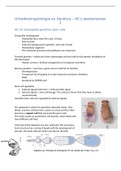Summary
Summary lectures Developmental Biology and Genetics (B-B3OBG05) (exam 2)
- Course
- Institution
Summary of the lectures of Developmental Biology and Genetics (B-B3OBG05). The summary is in English, as the lectures were also in English. Includes lectures: 10, 11, 12, 13, 14, 15, 16 and 17
[Show more]



